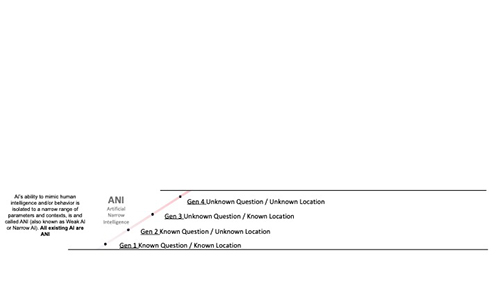Raising Artificial Intelligence
Figure 2. shows such a breakdown of Band 0 into four generations. The generations are distinguished by:
- Purpose, such as whether the question the system is seeking is known at the beginning of the process;
- Characteristics of the data the system is using, such as whether the data source is known.

Figure 2 - Breakdown of Band 1
Each of these two elements can be known or unknown. In Generation 1, the system knows both the question and the source of the data (typically a specific data lake). This combination is then an ANI Gen1 solution set. An example of such a system is one that seeks to answer the question, “Is someone trying to attack my SQL Database?” SQL D/B attacks show a specific pattern in SQL D/B log files. In this example, the AI system knows what it is looking for (the pattern) and knows where to look (the SQL D/B data lake that stores all of the log files). The SQL D/B may support Communications Service Providers’ (CSP’s) infrastructures. For example, the OSS (Operations Support Systems) and BSS (Business Support Systems) that were recently attacked in European CSPs. Here again, today’s systems are primarily Gen 1. So, we have three more generations in ANI before we even get to the beginning of the Band 2.
The generations proceed. In Generation 2, the initial system knows the question but not the location of the data to analyze to get to an answer. Extending the example above, the initial system knows the pattern it is looking for but does not know where the data exists to allow it to find that pattern. To accomplish its purpose, the system must “reason” and find the location of the data it needs.
In Generation 3, the initial system does not know the question but does know the location of the data to analyze to get to an answer. Again, extending the above example, the initial system may have a general purpose, such as to maintain the integrity of another system, but it doesn’t know anything about potential attacks, failures, and so on; or their patterns. It does know that it has access to a data lake containing the target system’s log files.
In Generation 4, the initial system knows neither its question nor the location of the data. This begins to blur into the beginning of the AGI Band. The best example of such a system might be the very early research work being done on LEELA. In this example, the initial system has been developed based on the human development theories of Piaget to have some basic cognitive abilities independent of questions (purpose) and data source. Work in this space is very preliminary, so it is difficult to say anything with certainty. But it appears that although Generation 4 could be very powerful, it probably requires massive amounts of data and long training cycles.
Training Bias?
We have talked about the data as a single thing. But there are (at least in Generation 1 as it exists today) two types of data: the data the system is “trained” on and the data the system uses in production. This concept of training is where the term Machine Learning (ML) gains importance. There are other valuable and important kinds of ML, but we will only talk about the one as it is used in Deep Neural Networks (DNN) here. One of the leading AI experts and the architect of a very significant AI microprocessor (commonly referred to as a TPU) said in a private workshop that we actually don’t know exactly how or why this kind of machine learning works, but it does. In these systems, a Deep Neural Network (DNN) is fed a “training data set.” This training data set is a sample of the real world and is subject to all the statistical problems with samples. Based on this data set, the DNN is trained to find certain patterns (the question). The resulting system is then pointed at “real world” data sets.



















